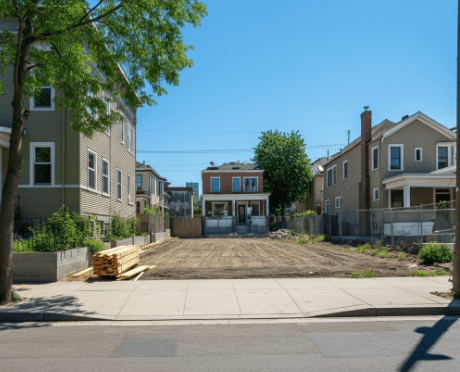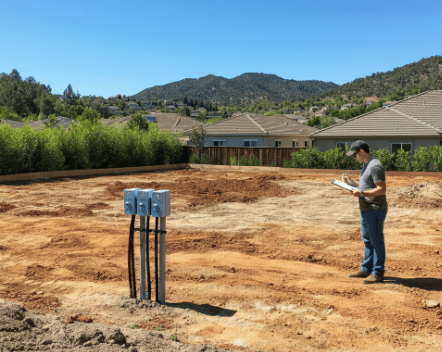Have you ever noticed a vacant, unused piece of land tucked between existing homes or buildings in a developed neighborhood? That’s likely an infill lot, and they are becoming increasingly valuable assets in urban and suburban areas. With land availability shrinking, studies show that infill development can be up to 45% more cost-effective for municipalities in terms of infrastructure. So, what is an infill lot? In simple terms, it’s a vacant parcel of land in an already developed area, ready for a new building. In this guide, we will explore everything you need to know about these unique properties, from their benefits to the challenges of their development. We will answer the question, “What is an infill lot?” in detail, helping you understand its true potential. Steve Daria and Joleigh, esteemed real estate investors and land cash buyers, excel at uncovering the true value of properties with expertise and precision. If you own an infill lot and are curious about its worth or considering selling, book a free, no-obligation discussion with our team today to explore your options.
What is an infill lot?
An infill lot is a vacant piece of land located within an established and developed neighborhood.
Think of it as an empty puzzle piece surrounded by existing homes, buildings, and community infrastructure.
These lots were often left undeveloped when the area was first built or became vacant after an old structure was removed.

Because they are situated in already built-out areas, infill lots usually have convenient access to existing services.
This includes connections to public roads, water, sewer lines, and electricity, which can make them very appealing for new construction projects.
Developing on an infill lot helps to revitalize communities and make smart use of available space, preventing urban sprawl.
For landowners, they represent a unique property type, and for builders, they offer a prime opportunity to add a new home in a desirable, mature location.
In essence, an infill lot is a ready-to-build space waiting for a new purpose right in the heart of a developed area.
This makes them a valuable asset in real estate markets where new land is scarce and demand for housing is high.
Get Started: Get Your Cash Offer Below…
We are direct land buyers. There are no commissions or fees and no obligation whatsoever. Start below by sharing where your property is and where we can send your offer…
What are the common sizes for infill lots?
The common sizes for infill lots can vary greatly, as there is no standard dimension for these unique properties.
Their size is often determined by the original layout of the neighborhood and how the surrounding land was divided.
A narrow lot is perfect for a tall, modern home, or a wider one suitable for a more traditional single-family house.
Some infill lots can even be large enough to accommodate a duplex or a small multi-unit building, depending on local zoning rules.
It is important to remember the core question: What is an infill lot? It is a vacant parcel within an existing community, and its size is simply what was left over or became available.
The dimensions are frequently irregular compared to lots in new subdivisions, which adds to their unique character.
Before purchasing, always get a professional survey to confirm the exact boundaries and total area.
This ensures your building plans will fit within the lot’s specific constraints and meet all local setback requirements.
How does zoning affect what I can build on an infill lot?
- Determines Building Type: Zoning codes specify whether a lot can be used for residential, commercial, or mixed-use purposes. For example, a lot zoned for single-family homes cannot be used to build an apartment complex or a storefront.
- Set Size and Scale Limits: These rules dictate the maximum height, square footage, and overall size of any new structure. Understanding “What is an infill lot?” involves knowing that these size constraints ensure it complements the surrounding properties.
- Defines Setback Requirements: Setbacks are rules that require buildings to be a certain minimum distance from the property lines, including the front, back, and sides. This ensures there is enough space between houses for privacy, safety, and access.
- Controls Lot Coverage: Zoning often limits the amount of the lot that buildings, driveways, and other non-permeable surfaces can cover. This answers “What is an infill lot?” in a practical sense by preserving green space and managing water runoff.
- Regulates Use and Occupancy: The regulations also control how a property can be used, such as prohibiting certain home-based businesses. This helps maintain the residential character of a neighborhood and prevents potential disruptions for neighbors.
Is it more expensive to build on an infill lot?
Building on an infill lot can sometimes be more expensive, but it’s not always a straightforward answer, as costs can vary.
The lot itself may cost more upfront due to its desirable location within an established neighborhood with existing amenities.
However, you can also enjoy substantial savings since essential infrastructure—like roads, water systems, and sewer lines—is already established.
This means you avoid the high costs associated with extending utilities to a remote piece of land.
When considering the question, “What is an infill lot?” Remember that its location is key.
Construction costs may be higher due to challenges such as tight spaces, which can limit access for large equipment and materials storage.
Additionally, building designs may need to adhere to stricter local regulations to match the existing neighborhood’s character.
Ultimately, while some aspects are more costly, the savings on infrastructure can often balance out or even reduce the total project expense.
What type of due diligence should I conduct before purchasing an infill lot?
- Verify Zoning and Building Codes: Contact the local planning department to confirm the lot’s zoning designation and understand all building codes. These regulations will determine what you can build, including the size, height, and type of structure allowed.
- Conduct a Title Search: A professional title search confirms the seller’s legal right to sell a property and uncovers any liens or claims against it. This step helps define the question, “What is an infill lot?” in legal terms by clarifying its ownership history.
- Perform a Land Survey: Hire a surveyor to officially mark the property boundaries and identify any easements or encroachments. A survey provides a precise map of your land, preventing any future disputes with neighbors over property lines.
- Complete Environmental and Soil Tests: Test the soil for stability and any potential contaminants, especially if a previous structure was on the site. Since the answer to “What is an infill lot?” involves its history, these tests ensure the ground is safe and suitable for construction.
- Confirm Utility Access and Capacity: Verify the location and capacity of all necessary utilities, including water, sewer, electricity, and gas. Ensure the existing connections are sufficient to support the new building you plan to construct.

How do I make a competitive offer on an infill lot?
To make a competitive offer on an infill lot, you need to present a clean and confident proposal that stands out to the seller.
Start by getting pre-approved for a loan, as this shows you are a serious and financially prepared buyer.
Next, work with your real estate agent to research recent sales of similar lots in the area to determine a fair market price.
A strong offer is not just about the price; it can also include favorable terms for the seller, like a quick closing date or minimizing contingencies.
Understanding the question, “What is an infill lot?” means recognizing its value in an established area, so your offer should reflect that.
It is also wise to write a personal letter to the seller explaining your plans for the property, which can create a positive connection.
By presenting a well-researched price and demonstrating your reliability as a buyer, you significantly increase your chances of a successful outcome.
Being flexible and responsive throughout the negotiation process is also key to securing the property.
For personalized advice on crafting the perfect offer, contact a real estate expert today.
Takeaway
- Infill Lots are Gaps in Existing Neighborhoods: An infill lot is simply a vacant piece of land situated within an already developed area. Instead of being in a new subdivision, these lots are like missing pieces in an established community, surrounded by existing homes, roads, and infrastructure.
- Location Offers Major Advantages: The prime location of an infill lot provides immediate access to established amenities, including schools, parks, and shops. More importantly, essential utilities such as water, sewer, and electricity are typically already available at the street, which can save significant time and money.
- Zoning and Regulations are Critical: Before purchasing, you must thoroughly investigate local zoning laws and building codes. These rules dictate everything from the building you can construct to how far it must be situated from the property lines, directly impacting the feasibility of your project.
- Costs Can Be a Trade-Off: While the land itself might be more expensive due to its desirable location, you often save money on utility connections. Construction costs can be higher at times due to challenges like limited space for equipment and materials on-site.
- Due Diligence is Non-Negotiable: A successful infill lot purchase requires thorough due diligence. This includes obtaining a land survey to confirm boundaries, conducting a title search to verify the absence of legal claims, and performing soil tests to ensure the ground is safe and stable for construction.
**NOTICE: Please note that the content presented in this post is intended solely for informational and educational purposes. It should not be construed as legal or financial advice or relied upon as a replacement for consultation with a qualified attorney or CPA. For specific guidance on legal or financial matters, readers are encouraged to seek professional assistance from an attorney, CPA, or other appropriate professional regarding the subject matter.
